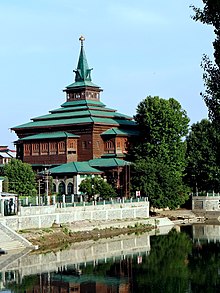Khanqah-e-Moula
| Khanqah-e-Mu'alla | |
|---|---|
خانقاہِ معلیٰ | |
 The Khanqah on the banks of Jhelum | |
| Religion | |
| Affiliation | Sunni Islam |
| District | Srinagar |
| Region | Kashmir Valley |
| Ecclesiastical or organizational status | Active |
| Status | Active |
| Location | |
| Location | Zaina Kadal, Srinagar |
| State | Jammu and Kashmir |
| Country | India |
| Geographic coordinates | 34°05′28″N 74°48′28″E / 34.091248°N 74.807771°E |
| Architecture | |
| Founder | Sultan Sikandar |
| Completed | 1395 CE, Rebuilt 1732 CE |
| Specifications | |
| Height (max) | 38m |
| Dome(s) | 1 (turret) |
| Minaret(s) | None |
Khanqah-e-Moula (Kashmiri: خانٛقاهِ معلىٰ), also known as Shah-e-Hamadan Masjid and Khanqah, is a mosque located in the Old City of Srinagar in Jammu and Kashmir, India. Situated on the right bank of the river Jhelum between the Fateh Kadal and Zaina Kadal bridges, it was built in 1395 CE, commissioned by Sultan Sikendar in memory of Mir Sayyid Ali Hamadani. It is held to be the first Khanqah—mosques associated with specific saints—in the Kashmir valley. It is one of the best examples of Kashmiri wooden architecture, and is decorated with papier mache.[1]
Construction
[edit]The mosque was commissioned by Sultan Sikandar Butshikan in 1395 CE in memory of the Islamic preacher Mir Sayyid Ali Hamadani, the central figure involved in the widespread conversion to Islam in Kashmir. Also known as Shah-e-Hamadan (the King of Hamadan), the preacher came to Kashmir from the city of Hamadan, Persia in the 14th century. He is credited for the spread of Islam in Kashmir. In 1480 AD, the shrine was destroyed in a fire. The then ruler, Sultan Hassan Shah, expanded its premises and rebuilt it. In 1731 CE, the Khanqah was again destroyed by fire and then rebuilt by Abdul Barkat Khan.
Background
[edit]
Local Hindus were involved in various communal disputes and repeated altercations by 1942, agitating for the right to build a covered shrine adjacent to the Muslim shrine,[2] which eventually led to a boycott of Muslim-owned shops by Kashmiri Hindus.[3]

Adjacent Kalishri Mata Shrine
[edit]Toward the River Jhelum, there is a wall marked with Sindoor (or Sindooram, a traditional vermilion red or orange-red colored cosmetic powder from India, usually worn by married women along the parting of their hair) but not a temple and water oozes at a place, which Kashmiri Hindus say is dedicated to goddess Kali.[4][2]

Fire of 2017
[edit]On 15 November 2017, a fire broke out in the shrine which damaged the spire of the building. Fire tenders were brought on the scene and they managed to arrest the spread of the fire which prevented any further damage to the building.[5]
Restoration work was immediately started[6] and on 30 March 2018, a refurbished crown was successfully installed on the spire of the shrine.[7]
See also
[edit]References
[edit]- ^ "Asian Historical Architecture: A Photographic Survey". Asian Architecture.
- ^ a b Rai, Mridu (2004). Hindu Rulers, Muslim Subjects: Islam, Rights, and the History of Kashmir. Hurst. ISBN 9781850656616.
- ^ Khan, Ghulam Hassan (1980). Freedom movement in Kashmir, 1931-1940. Light & Life Publishers.
- ^ "Maha Kali temple co-exists with Khanqah". Rising Kashmir. Archived from the original on 15 January 2019. Retrieved 15 January 2019.
- ^ "Khankah-e-Moula shrine damaged in Srinagar fire". 15 November 2017. Retrieved 5 May 2019.
- ^ "Latest News From Kashmir, Breaking News, Current Headlines, Kashmir News Online | Greater Kashmir". Retrieved 5 May 2019.
- ^ "Khankah-e-Maulla gets refurbished crown". 31 March 2018. Retrieved 5 May 2019.
External links
[edit]Text is available under the CC BY-SA 4.0 license; additional terms may apply.
Images, videos and audio are available under their respective licenses.

